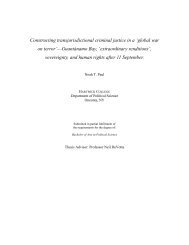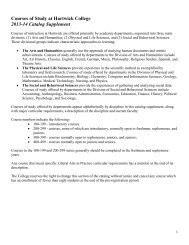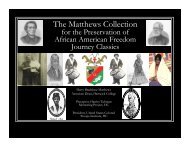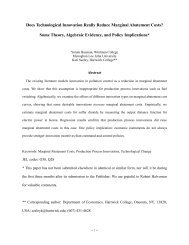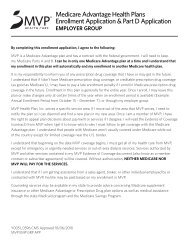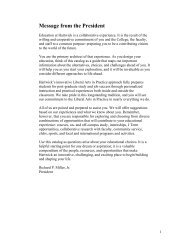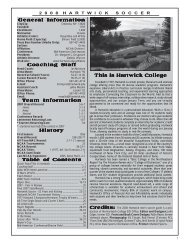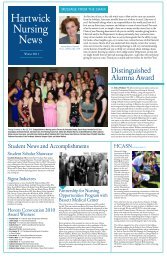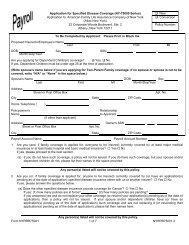Table of Contents - Hartwick College
Table of Contents - Hartwick College
Table of Contents - Hartwick College
Create successful ePaper yourself
Turn your PDF publications into a flip-book with our unique Google optimized e-Paper software.
the value <strong>of</strong> the dollar and other currencies. Prerequisite: Two different<br />
numbered courses from Econ 250-259, Topics in Economics (SBA)<br />
303 Econometrics (4 credits) The method by which real world data is<br />
used to test economic theory and/or to make predictions about future<br />
economic events. Presents regression analysis as a tool with which the<br />
statistical relationship between economic variables may be rejected or<br />
validated. Equal time is devoted to understanding econometric theory and<br />
to the direct application <strong>of</strong> that theory to analysis. The course culminates<br />
with students preparing an analytical research paper on a specific<br />
question <strong>of</strong> personal interest. Prerequisite: Math 108, Math 121 or a Math<br />
course at the 200 level. (SBA)<br />
311 Economic History (3 credits) Explores economic causes and<br />
consequences pertaining to the development <strong>of</strong> markets in a research<br />
seminar setting. Recent topics for investigation have included: the origins<br />
<strong>of</strong> plantations, the emergence <strong>of</strong> multinational corporations from 1850 to<br />
1900, and 19 th and 20 th century labor history. Common readings are<br />
initially discussed and then each student undertakes a substantial project<br />
to investigate a specialized theme. (SBA)<br />
313 Classical Political Economy (3 credits) Contemplates the<br />
economic, political and philosophical “visions” in Adam Smith’s Wealth <strong>of</strong><br />
Nations, Karl Marx’s Capital, and John Maynard Keynes’ General Theory.<br />
The development <strong>of</strong> the liberal ideal <strong>of</strong> unrestrained individual freedom is<br />
traced through the ways these economists interpreted the social reality <strong>of</strong><br />
their time. The evolution <strong>of</strong> neoclassical economics is also considered, and<br />
the contemporary relevance <strong>of</strong> these works is discussed throughout the<br />
course. (SBA)<br />
314 Development and Transition (3 credits) Considers various<br />
explanations for the disparate levels <strong>of</strong> economic well-being among<br />
nations, both historically and currently. Issues include the potential trade<strong>of</strong>f<br />
between economic growth and societal equity, miracles and failures,<br />
the sustainability <strong>of</strong> certain development plans, the feasibility <strong>of</strong> “trickle<br />
down” development, and innovative development techniques at both the<br />
grassroots and macro levels. The course culminates with students creating<br />
and defending development plans for a nation <strong>of</strong> their choice.<br />
Prerequisite: One course from Econ 250-259. (SBA)<br />
315 Government Policy (3 credits) A critical look at contemporary<br />
domestic policy issues using the tools <strong>of</strong> theoretical and empirical<br />
economic analysis, institutional analysis and the history <strong>of</strong> social policy.<br />
Potential topics include crime, child care, education, medical care, social<br />
security and long term care for the elderly. A significant portion <strong>of</strong> the<br />
course will be devoted to independent student assessment <strong>of</strong> current<br />
policy initiatives-specifically their costs and benefits-and the design <strong>of</strong><br />
policy reform initiatives. Prerequisite: One course from Econ 250-259.<br />
(SBA)<br />
316 Race and Gender (3 credits) Utilizes economic analysis to shed<br />
light on the social issues <strong>of</strong> race and gender in contemporary United<br />
States society. Potential topics include labor and credit market<br />
discrimination, employment and housing segregation, the male-female<br />
and black-white wage gap, labor market participation, divorce and<br />
domestic violence. While neo-classical economic theory will serve as a<br />
point <strong>of</strong> departure for each issue, the assumptions behind the theory will<br />
94



